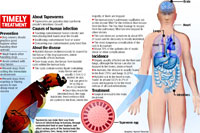01 November 2011
By Malathy Iyer
Jalgaon, India
Rehana, a humble shopkeeper’s wife from Jalgaon, has been a much-discussed patient in Nair Hospital, Mumbai Central, ever since surgeons there pulled out three translucent balls from her heart. These crystal-like objects, each measuring around 2 cm in length (see pix), are not as benign as they look, ays Dr Kanak Nagle, who heads the medical school’s cardiothoracic surgery department. “These are cysts conaining eggs of tapeworms,” he adds.
He and his team studied medical extbooks to ensure the cysts don’t burst during Rehana’s open heart surgery performed on October 14. “The cysts covered almost 30% of her left ventricle, the heart’s main pumping chamber,’’ says Dr Nagle. If these cysts had burst, their protein could have triggered a life-threatening allergic reaction (anaphylactic shock) that could have stopped he heart’s circulation system within minutes. Pieces of the cysts could also have blocked blood flow in the arteries.
But the worst is not yet over for Rehana (name changed on request), who has many such cysts lodged in her brain. Doctors presume she got the infection from a pet dog; dogs eat meat infected with hydatid tapeworm and their faeces spread the cysts around. “In humans, hydatid cysts usually attach themselves to the liver or lungs. It’s extremely rare to have such a cyst in the heart,’’ said Dr Anil Patwardhan, former head of KEM Hospital’s cardiac surgery department and present vice-chancellor of Datta Meghe Medical College in Wardha.
Tapeworms are parasites that can live in people’s intestines (bowel). These flatworms spread to humans when they touch contaminated faeces, swallow food or water containing traces of contaminated faeces or eat raw contaminated meat or vegetables. The hydatid tapeworm is mainly found in canines.
Research from Iran, one of the most endemic countries, shows the incidence of the disease is 1-200 per 1,00,000 people. Depending on the organ it’s attached to, complications can range from obstruction in bile ducts, lungs’ bronchial branches or liver cirrhosis, etc. “It’s quite endemic in Vidharba region of Maharashtra,’’ says Dr Nagle.
As the medical team pored through journals for references for Rehana’s case, it found entries on cysts in the heart’s outer covering. “It’s significant these cysts were growing in the heart’s main pumping chamber or the left ventricle,’’ says Dr Nagle.
Such cysts keep growing for years without symptoms. “Their presence in the heart is always an accidental discovery,’’ he says. Rehana’s disease was discovered due to “weakness’’. “Doctors in Jalgaon felt the weakness was due to my pregnancy,’’ says the 22-year-old. But it worsened after her daughter’s birth. “My fingers and arms would become numb,’’ she says.
When her daughter was a few months old, her parents brought her to JJ Hospital, Byculla, where doctors zeroed down on cysts in her brain and asked her to undergo a neurosurgery. “But a CT scan showed something in my heart.’’
A closer study revealed cysts in her heart. Jalgaon’s local politicians then asked Dr Nagle’s team to operate on Rehana. The operation has not lessened the young mother’s worries. “I haven’t seen my daughter for over 45 days now. And doctors say that I will need another surgery to remove the cysts from my brain,’’ she says.

The Patient | A 22-year-old mother from Jalgaon
What | Hydatid cysts ( a type of tapeworm) in the heart and brain
Treatment | An open heart surgery to remove three hydatid cysts from the left ventricle
Now | The heart is fine, but cysts in the brain need to be tackled as they have neurological effects such as numbing of extremities







